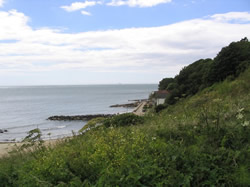Battle of Bonchurch
| Battle of Bonchurch | |||||||
|---|---|---|---|---|---|---|---|
| Part of the French invasion of the Isle of Wight during the Italian War of 1542–1546. | |||||||
 Monks Bay in 2008. French troops advanced from the bay before they reached St. Boniface Down, the location where the fighting took place. |
|||||||
|
|||||||
| Belligerents | |||||||
|
|
|
||||||
| Commanders and leaders | |||||||
|
|
|
||||||
| Strength | |||||||
| Approx 500 soldiers | 300-2800 militiamen | ||||||
| Casualties and losses | |||||||
| Unknown | Unknown | ||||||
The Battle of Bonchurch took place in late July 1545 at Bonchurch on the Isle of Wight. No source gives the precise date, although 21 July is possible from the sequence of events. The battle was a part of the wider Italian War of 1542–1546, and took place during the French invasion of the Isle of Wight. Several landings were made, including at Bonchurch. Most accounts suggest that England won the battle, and the French advance across the island was halted.
The battle was between French regular soldiers, and local English militiamen. The number of French soldiers involved is believed to be about 500, with the number of militiamen uncertain, with one source stating 300 and another 2,800. The English forces are believed to have been commanded by Captain Robert Fyssher, and the French by Le Seigneur de Tais.
The battle was one of several fought between English and French on the Isle of Wight. The majority of sources state that the English won, although one suggests that the French were victorious. The battle was fought as part of the French attempt to cause enough damage to force English ships to leave their defensive positions and attack in less favourable conditions. Other French landings were made at Sandown, Bembridge and St Helens.
The Italian War of 1542-1546 arose from a dispute between Holy Roman Emperor Charles V and Francis I of France, which had not been settled by the Italian War of 1535-1538. This led to war between France, backed by the Ottoman Empire and Jülich-Cleves-Berg, and the Holy Roman Empire, backed by the Kingdom of England, Spain, Saxony, and Brandenburg. After two years of fighting Charles V, and Henry VIII invaded France. In September 1544, English forces captured Boulogne. France failed to re-capture the city by force. Peace talks between England and France were unsuccessful, partly because Henry VIII refused to return Boulogne. As a result, Francis I decided to invade England, hoping that Henry VIII would return Boulogne in return for his leaving England. Thirty thousand French troops and a fleet of some 400 vessels were assembled, and sailed from Le Havre on 16 July.
...
Wikipedia
